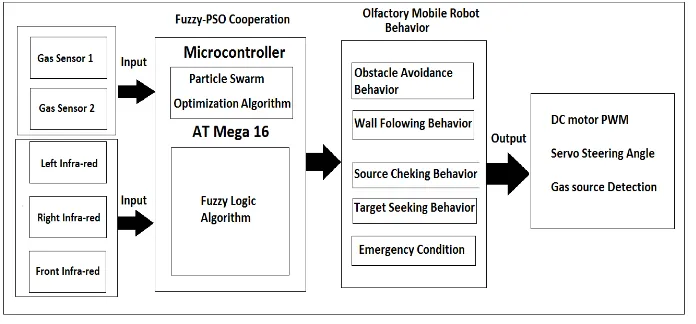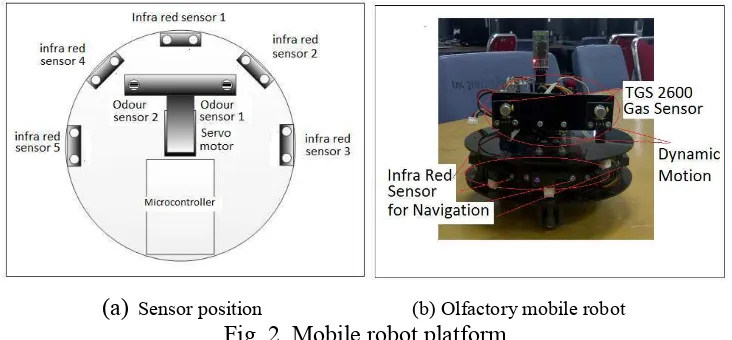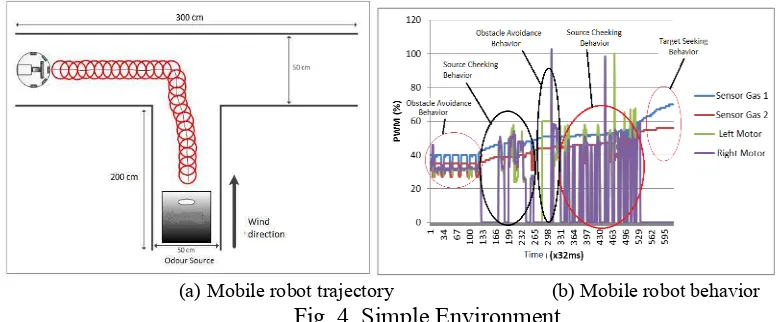A New Navigation of Behavior-Based Olfactory Mobile Robot
Siti Nurmaini, Bambang Tutuko, and Aulia Rahman T
Robotic and Control Research Lab, Faculty of Computer Science, University of Sriwijaya, Jl Raya Palembang-Prabumulih, Km 32, Inderalaya-Ogan Ilir, Indonesia
siti_nurmaini@unsri.ac.id, beng_tutuko@yahoo.com, auliarahman.thoharsin@gmail.com
Keywords:odour sensor, olfactory mobile robot, behavior-based, Fuzzy-PSO
Abstract. In this paper a new olfactory mobile robot application is proposed where dynamic olfaction system is used on a mobile robot in order to acquire the gas/odour property of objects. Olfaction system with two dynamic gas/odour sensors can be moved in in order to be able to detect source in many directions. We examine the problem of deciding when, how and where the gas/odour sensor should be activated by planning for active perception use behavior-based architecture. Simple form of cooperation between Fuzzy Logic control and Particle Swarm Optimization (PSO) is implemented in the navigation strategies. The real experiments performed on a simple mobile robot equipped with dynamic gas/odour sensor and three infra-red sensor. The initial result shows that olfactory mobile robot that is capable of locating the source of a simulated chemical leak in an environment while detecting and avoiding obstacles along its path.
Introduction
Olfaction is widely used by animals in many activities, such as searching for food, finding mates, exchanging information, and evading predators. The ability of animals to track odor plumes to their source is well known [1-4]. In the early 1990s, motivated by the olfaction abilities of these animals, researchers started to try building mobile robots with similar olfaction abilities to replace trained animals [5]. Olfaction is not a common sense in the mobile robotics field, but the large number of important applications that can be solved with this sense fostered the research in this area.
Integration mobile robot with olfaction system is a new computation and behavioral application metaphor for solving real-world problems including the search of a chemical leak in an indoor environment. It is based on the principles underlying the behavior of a natural agent consisting of an electronic olfaction system that can simulate an animal olfaction system. The usefulness of such integration system is particularly evident when the robot need to carry-out some chemically related task, like environmental monitoring [5,6,7]. The most common tasks in this field such as the search and localization of an odour source releasing chemical substances to the unknown environment, usually volatiles to the atmosphere. These chemicals are transported through the environment, generating an odour plume. In this situation, the mobile robot tasks which are searching the source in the unknown environment, trying to make contact with the plume, after detecting the plume, the mobile robot should to find the gas/odour source.
Currently, the methods use in robot-based olfaction research can be classified into analytical-model-based and behavior-based method [8]. Analytical-model based methods have proposed by researchers to estimate the localization of the odor source in real time [9-13]. However, the analytical-model based odor-source estimation could make up for the disadvantage of commonly used gas sensors with small detection range as well as the discrete distribution of plumes caused by turbulence.
In the behavior-based methods, the tasks can be decomposed into three sub-procedures namely, plume finding, plume traversal, and source declaration [14] or four sub-procedures, namely, finding a plume, tracing the plume, reacquiring the plume, and declaring the source [15]. Most methods using the behavior-based methods are proposed [16-25]. However, only a few publications have discussed the olfactory mobile problem with real experiments and these experiments just observe odour behavior based, while navigation behavior is rarely observed. While some engineering
applications such as tracking in an outdoor urban environment and tracking inside a damaged building must use both of navigation and odour behavior.
Hence, this research contributes towards producing olfactory mobile robot with new behavior-based olfactory architecture giving way to improve performance of mobile robot. The problem of deciding when, how and where the gas/odour sensor should be activated is examined by planning for active perception use Fuzzy-PSO strategies.
OlfactoryMobileRobotNavigationBehavior
A common approach to control mobile robot navigation, that use behavior-based architecture which is the Subsumption Architecture [26]. In behavior-based architecture the actuators are tightly coupled to the sensing layers of the robot through independent processes that implement a set of target oriented behaviors. The control signal to the actuators is output of active behavior with higher priority level or combination from output of all active behaviors. It is common to find in navigation control architecture a repulsive behavior such as, to avoid collision with obstacles, to follow walls and to reach target.
In this study, navigation task consists of planning the path of mobile robot movement and control its realization to achieve the target. Simple form of cooperation between Fuzzy Logic and Particle Swarm Optimization (PSO) (Fuzzy-PSO) is implemented in the navigation strategies. The basic Fuzzy-PSO algorithm is slightly modified to accommodate mobile robot navigation tasks and search application. In this strategy, fuzzy logic technique is used for navigating while PSO for finding the gas/odour source in dynamic environment. The behavior with the highest priority among those activated and transmits the commands to the motors. Olfactory signal from gas/odour sensor is a direct indication of a certain chemical substance presence.
Fig. 1 Olfactory mobile robot behavior
The behavior-based navigation algorithms such as, obstacle avoidance behavior, wall following behavior, source checking behavior, target seeking behavior and emergency condition is used to achieve gas/odour source, as shown in Fig. 1. The integration of fuzzy logic and particle swarm optimization (PSO) technique for navigation strategy has been carried using five behaviors as follows;
1. Collision avoidance behavior: The mobile robot takes arched paths with randomly movement in complex and simple environment. This behavior is always activated using fuzzy logic technique. However, it emerges only when no or olfactory signal is detected. Since its priority is the lowest, the collision avoidance behavior is suppressed whenever the other target seeking behavior is activated.
sides. When olfactory signal is high, this behavior priority is lowest and the target seeking is highest priority.
3. Target Seeking behavior: This behavior keeps mobile robot heading to the target and regulates the difference between the mobile robots current position and the target. when odour is active high in the odour sensor, the target seeking behavior is activated. The direction and distance to the object are measured by using PSO technique. The mobile robot drives to the location of the odour source.
4. Source checking behavior: This behavior has the highest priority at 2 level. It active when the mobile robot in the junction. The mobile robot stops for a while and measures the response of the dynamic gas/odour sensor for 0.25 s. If odour with high concentration exists the search is terminated and the robot declares that a source is found. Otherwise, the mobile robot makes a turn or move to a new direction to prevent going to the same object again. The mobile robot then moving the random or target seeking behavior.
5. Emergency behavior: In some condition, avoid-obstacle behavior may not function properly and the mobile robot move too close to an obstacle. In such cases, an emergency condition is required to stop the mobile robot or even, in some instances, the mobile robot need to make turn back move. This condition depends on the safest allowable distance between the mobile robot and the obstacle. This behavior has the highest priority at 1 level.
Experimental Set-Up
The Olfactory Robot
The olfactory mobile robot is mainly applied to track plumes and search for gas sources. The robotic platform provides the ability to move across in real environment. In this work small olfaction mobile robot is used in circular shape about 30 cm diameters and has about 25 cm of height. Mobile robot structure based on a three-wheel vehicle which is mainly composed of two driving wheels and an all-direction wheel.
(a) Sensor position (b) Olfactory mobile robot Fig. 2. Mobile robot platform
Sensing System
High sensitivity, long life-span and low cost make Metal Oxide Semiconductor (MOS) sensors the most widely used odour sensors in mobile robots. strong dependence on the external environment (temperature/humidity) which will influence the accuracy of gas concentration measurements. A kind of MOS sensor TGS2600 is used in our olfatory mobile robot experiments. TGS2600 consists of a silicon semiconductor layer formed on an alumina substrate of a sensing chip together with an integrated heater. In the presence of a detectable odour, the voltage across the heater causes an oxygen exchange between the volatile odour molecules and the metal coating material. Electrons are attracted to the loaded oxygen and result in decreases in sensor conductivity.
Sensors is tested in a hermetically closed box, where a known increasing amount of metanol. Methanol, also known as methyl alcohol, wood alcohol or spiritus, is a chemical compound with chemical formula CH3OH. A fan is included to accelerate metanol vaporization and homogeneous dispersion. The tested gas/odour source positions are indicated by a box square with a fan as shown in Fig. 3 (a) and two odour sensor in the mobile robot. The sensor outputs are recorded after the readings got steady. The calibration sensor device is given in Fig. 3 (b).
(a) Odour source (b) Odour sensor output from ADC Fig. 3. Characteristic of gas/odour sensor
Experimental Result
Implementations are conducted in experimental setups available at our robotic laboratories in a room 5 m × 5 m. During the experiments, the doors and windows of the room were kept shut. Ethanol, which is a volatile and colorless liquid is used as chemical gas source. In this experiment, the mobile robot move using a random walk strategy at a maximum speed of 0.3 m/s. Whenever a mobile robot is trapped in a local minima or reached a goal boundary, it received a new target position chosen randomly from the workspace.
(a)Mobile robot trajectory (b) Mobile robot behavior Fig. 4. Simple Environment
out, with an experimental setup composed of a olfactory mobile robot for gas/odour source detection.
From Fig. 4 (a) and (b) it can be seen mobile robot trajectory, PWM value and output of the odour sensor, respectivelly. From Fig. 4(a), in simple environment fuzzy logic technique is used at 32 ms to 4.2 s when obstacle avoidance behavior active, that enabled the olfactory mobile robot to maintain its position in the middle of the coridor. At 4.2 s to 9 s mobile robot move randomly to check the position of the odour source, when the mobile robot meet the junction, than source checking behavior is activated. At 9.1 s to 9.8 s the mobile robot make turn right because it detects a higher value of odour sensor readings in the right of mobile robot. PSO active at 9.8 s to 17 s, when sensor readings increase and the mobile robot closer to odour source, it can be seen in Fig. 4(b). By using behavior based control strategy based on combination Fuzzy-PSO technique, the olfactory mobile robot should be able to localize source it self, measure local odour concentrations, keep the position of higher concentration and succesfully to reach the target.
Conclusion and Future Work
The methodology of tracing odor source using behavior-based architecture through an olfactory mobile robot is considered in this research. The initially experimental results show that by using propose navigation strategy, the mobile robot could successfully use olfaction to achieve gas/odour source in unknown environment. As future work we would like to consider the extension to the problem of classification in environments where more than one substance is present and validate the algorithms searching gas/odour sources in a large real testing setup.
Acknowledgment
Authors thank to Higher Education General Director (DIKTI), the Ministry of National Education Department Indonesia and Sriwijaya University under Research of International Collaboration for their financial support in Competitive Grants Project. Our earnest gratitude also goes to all researchers in Robotic and Control Laboratory, Computer Engineering, Sriwijaya University who provided companionship and sharing of their knowledge.
References
[1] Sandini, G., G. Lucarini and M. Varoli. Gradient driven self-organizing systems. in
Proceedings of IEEE/RSJ International Conference on Intelligent Robots and Systems. Yokohama, Japan: IEEE. (1993).
[2] Consi, T.R., et al. AUV guidance with chemical signals. in Proceedings of IEEE Sympsium on Autonomous Underwater Vehicle Technology. Cambridge, MA, USA: IEEE. (1994).
[3] Russell, R.A., D. Thiel and A. Mackay Sim. Sensing odour trails for mobile robot navigation. in Proceedings of IEEE International Conference on Robotics and Automation. San Diego, CA, USA: IEEE. (1994).
[4] Ishida, H., et al. Study of autonomous mobile sensing system for localization of odor source using gas sensors and anemometric sensors. Sensors and Actuators A: Physical, 45(2): 153-157. (1994).
[5] Loutfi, A., Broxvall, M., Coradeschi, S., and Karlsson, L. Object recognition: A new application for smelling robots. Robotics and Autonomous Systems, 52:272–289. (2005).
[6] Taylor, B., Willis, M., and Quinn, R. Integrating olfaction, vision and touch to locate fluid-borne odors in diverse and dynamic environments. International Conference on Applied Bionics and Biomechanics Venice, Italy October 14-16. (2010).
[7] Marques, L., Nunes, U., and A. T. de Almeida. Particle swarm-based olfactory guided search.
[8] Meng, Q.H., Yang, W.X., Wang, Y., and Zeng, M. Collective Odor Source Estimation and Search in Time-Variant Airflow Environments Using Mobile Robots. Sensors, 11(11): 10415– 10443. (2011).
[9] Ishida, H., Nakamoto, T., and Moriizumi, T. Remote sensing of gas/odor source location and concentration distribution using mobile system. Sens. Actuat. B 49, 52-57. (1989).
[10]Hinze, J.O. Turbulence; McGraw-Hill: New York, NY, USA, (1975).
[11]Kowadlo, G.. and Russell, R.A. Using naive physics for odor localization in a cluttered indoor environment, Auton. Robot. 20:215-230. (2006).
[12]Farrell, J.A., Pang, S., and Li, W. Plume mapping via hidden Markov methods. IEEE Trans. Syst. Man Cybern. Part B Cybern., 33: 850-863. (2003).
[13]Pang, S., and Farrell, J.A.Chemical plume source localization. IEEE Trans. Syst. Man Cybern. Part B Cybern. 36:1068-1080. (2006).
[14]Hayes, A.T., and Martinoli, A. Goodman, R.M. Distributed odor source localization. IEEE Sens. J. 2:260-271. (2002).
[15]Li, J.G., Meng, Q.H., Wang, Y., and Zeng, M. Odor source localization using a mobile robot in outdoor airflow environments with a particle filter algorithm. Auton. Robot. 30:281-292. (2011).
[16]Marjovi, A and Marques, L. Multi-robot olfactory search in structured environments. Robotics and Autonomous Systems, 59:867–881. (2011).
[17]Li, J., Yang, J., Cui, S., and Geng, L. Speed limitation of a mobile robot and methodology of tracing odor plume in airflow environments. Advanced in Control Engineeringand Information Science, Procedia Engineering, 15:1041–1045. (2011).
[18]Song, K., Liu, Q., and Wang, Q. Olfaction and Hearing Based Mobile Robot Navigation for Odor/Sound Source Search. Sensors, 11:2129-2154. (2011).
[19]Ishida, H., Yoshikawa, K., and Moriizumi, T. Three-dimensional gas plume tracking using gas sensors and ultrasonic anemometer. Proceedings of Sensors, IEEE. (2004).
[20]Russell, R.A., Alireza, B.H., Shepherd, R.L., and Wallace, G.G. A comparison of reactive robot chemotaxis algorithms. Robot. Auton. Syst. 45:83-97. (2003).
[21]Russell, R.A. A Ground-Penetrating Robot for Underground Chemical Source Location. In
Proceedings of IEEE/RSJ International Conference on Intelligent Robots and Systems, Edmonton, AB, Canada, 2–6 August pp. 175-180. (2005).
[22]Li, W., Farrell, J.A., and Card, R.T. Tracking of fluid-advected odor plumes: Strategies inspired by insect orientation to pheromone. Adapt. Behav, 9:143-170. (2001).
[23]Ferri, G., Caselli, E., Mattoli, V., Mondini, A., Mazzolai, B., and Dario, P. SPIRAL: A novel biologically-inspired algorithm for gas/odor source localization in an indoor environment with no strong airflow. Robot. Auton. Syst. 5:393-402. (2009).
[24]Zarzhitsky, D., Spears, D., and Thayer, D. Spears, W. Agent-based chemical plume tracing using fluid dynamics. Lect. Notes Artif. Intell. 3228:146-160. (2004).
[25]Farrell, J.A., Pang, S., and Li, W. Chemical plume tracing via an autonomous underwater vehicle. IEEE J. Ocean. Eng. 30:428-442. (2005).


